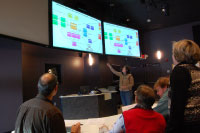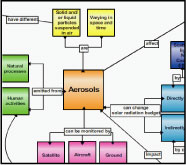COSEE-OS recently partnered with the Seacoast Science Center (SSC) in Rye, NH to develop content for a staff workshop focusing on the complex topic of ocean aerosols. Thanks to grant funding, University of New Hampshire (UNH) scientist Dr. Hui Feng has been working with the SSC to translate his research on ocean aerosols and modeling into programs for the public at approximately a third grade level.
The purpose of the training was two-fold: to increase the staff’s comfort level with the content and to provide resources for educators who are planning programs. Tools created by COSEE-OS, including a vetted database of scientific resources, were used to enrich the staff’s training.
Perrin Chick, SSC Director of Education, lead the workshop of approximately 20 members of seasonal and full-time staff.
Dr. Feng’s NASA New Investigator grant has funded Amy Cline (UNH/COSEE-OS educator) to create materials, content resources and run staff development workshops. Amy has created unique lesson plans on questions such as: What are ocean aerosols? Where do they come from, and how are they created? She created simple matching games connecting images with content, as well as several “demonstration boxes” that illustrate how air quality and aerosols are connected.
At the training session, an interactive concept map (see image, below right) was employed to help the SSC staff learn how ocean aerosols are connected to broader pieces of the ocean-climate system. The original concept map was co-created by Dr. Feng, SSC staffer Kate Leavitt, and graduate student/informal educator Carrie Armbrecht during the June 2009 COSEE-OS Scientist-Informal Educator workshop.
To assist in programming efforts, staff members were trained on two free online tools: the
Ocean Climate Interactive (OCI) and the
Concept Map Builder (CMB) (described
here). The OCI provides access to scientist-vetted assets - videos, news articles, lesson plans and images – that help SSC educators better understand and explain ocean aerosols or other ocean-climate topics to the visiting public. The CMB, which allows users to create concept maps containing embedded links to the resources in the OCI, helps the staff visualize and communicate their current ideas about ocean aerosols (or other science topics) by creating their own custom concept maps. The SSC plans to gather feedback from the staff in January 2010 to see if and how they are using the new resources in their programming.
Breaking down complex science topics into their essential components for a lay audience is challenging. COSEE–OS is helping SSC staff development through concept map training, providing resources, identifying gaps in knowledge, and fostering peer-based relationships between informal educators and scientific researchers. In this particular case, COSEE-OS has successfully helped connect one scientist, one informal science center, and potentially thousands of visitors with new, exciting and accurate information about ocean aerosols.







